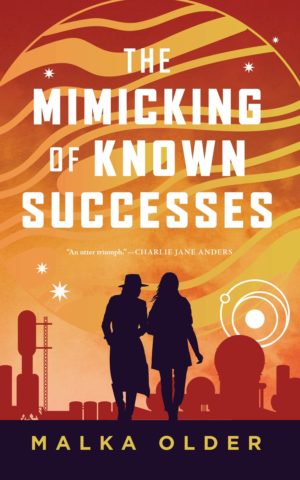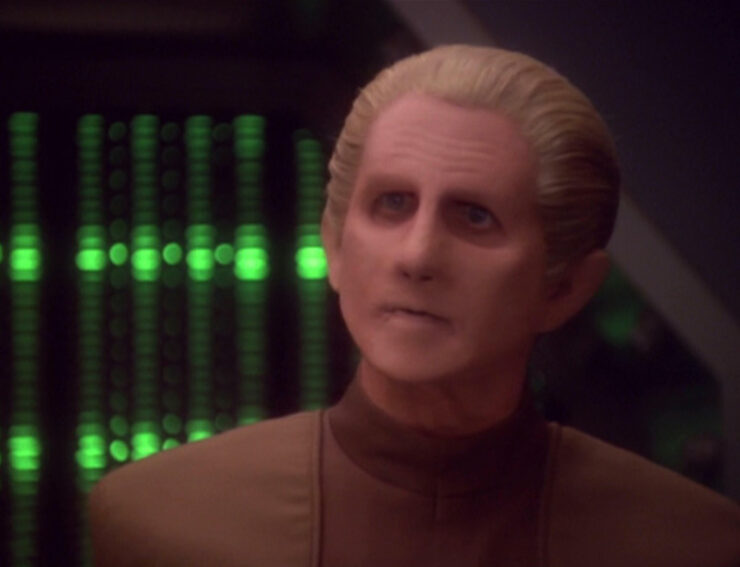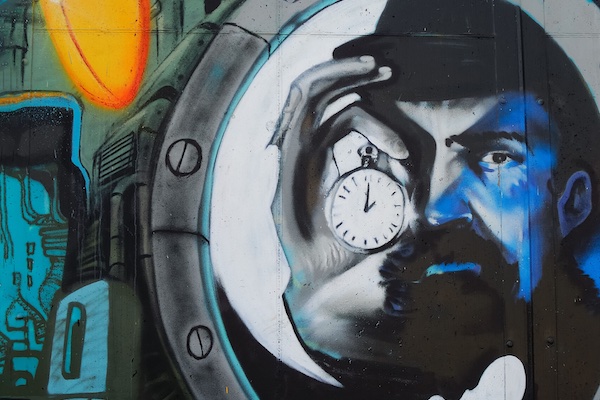Aside from werewolves, there are remarkably few shapeshifters in fantasy films. Even the great Ladyhawke stars a knight who turns into a wolf, along with its lady who turns into a hawk. Science fiction, by contrast, along with its fantastical cousin the superhero epic, loves its metamorphing aliens.
There’s just something about protean lifeforms that makes an auteur’s heart go pitty-pat. Star Trek’s Changelings are a classic example of the species. They’re the natural offspring of that classic creature from outer space, the Thing. They’re ancient and mysterious; and they’re puddles of goo that can only hold solid form for a few hours before they have to revert to the native liquid.
We first meet them in Deep Space Nine, in the person of Odo, the security chief with the strange, unfinished-looking face. Odo is a foundling; he doesn’t know what he is or where he comes from, only that he can transform into anything at all, from an inanimate object to a humanoid alien. As the series goes on, he learns that he’s one of a species called the Founders, and that he’s part of a great experiment. A hundred infant Changelings were sent out in containers to various species, to discover how those species would react to a Changeling.
By the time the series ends, the Founders have been revealed to be the dominant species of the Dominion, which rules in the Gamma Quadrant, and they’ve gone to war against the species of the Alpha Quadrant, including the Federation. In short, they’re the bad guys. And then in Picard, they’re at it again, doing their best to destroy the Federation from the inside out.
Changelings in this universe represent two fundamental fears: that the person we’re talking to might not actually be that person, but a simulacrum, a mimic—a false image; and that a species might consist not of separate individuals but of a group or hive mind, which the Founders call the Great Link. Although the Federation’s ideals are all about cooperation and collaboration, the root assumption is individualism good, hive mind bad. Individuals are all about doing things together, but when they get together mentally as well as physically, their first impulse is to conquer everybody else.
Unlike the Borg, who want to turn everyone into themselves, the Founders are more into plain old galactic domination. They do this by taking on the appearance of members of the species they’re trying to dominate. It’s more than mimicry; it’s transformation down to the cellular level.
There are ways to tell: extract blood, and once removed from the main body, it reverts to primordial goo. By the time of Picard, they’ve found a way to circumvent that, which means in turn finding a way circumvent the circumvention. You have to love the ever-morphing worldbuilding that is Trek.
Changelings were deliberately designed to be scary. The name itself is very old in human lore and legend. The original changelings were faery creatures left in the cradles of human children (or, more rarely, adults might be taken away and changelings be left in their place). They might look like the humans who had been stolen, but they would immediately or gradually reveal their inhuman nature, sometimes by dwindling and dying, sometimes by weird and antic behavior, sometimes by demonstrating unusual knowledge or wisdom. In every case, the real person would be stolen away, and the false one be left in its place.
Trek Changelings fight dirty. They can take on the form of any person, all the way up to the top of the power structure. They’re the ultimate spies. They can infiltrate any institution. They may take over the government; they may take control of an interstellar fleet. By the time non-Changelings have figured out what’s happening, it’s very late in the game, and very difficult to eradicate the threat.
Buy the Book


The Mimicking of Known Successes
In Deep Space Nine, the Alpha Quadrant wins, but it’s a terrible victory. It is, quite frankly, genocide. There’s no other way, we’re told. The Founders can’t be defeated by any ethical or moral means. They have to be eradicated.
There is an out at the end. An antidote. A way to save a few of the Founders. Which reverberates through the universe and leads to the events of Picard. And that’s dark, too, and apocalyptic, and the scary, scary thing is that you can’t know if the person you’re talking to is one of you, or the scary, scary, bad, mean, angry, vengeful alien.
It’s a deep human fear. What if you’re not real? What if you can anything you want or need to be? And what if you’re profoundly prejudiced against us “solids”? We are what we are. We can’t shift at will. We’re not a liquid by nature.
But there’s another layer to that, too. The reason why the Founders are so biased against solids is because solids are so biased against them. They’re two incompatible states, and they’re both out to destroy each other.
That, when I think about it, is fundamental Trek. The utter illogic of prejudice, and the utter intransigence of it. A classic example is the Original Series’ episode, “Let That Be Your Last Battlefield.” The antagonists here aren’t shapeshifters, they’re two aliens with diametrically opposed color patterns, each of whom is absolutely convinced that the other pattern is The Enemy. They can’t be dissuaded. They can never be reconciled. They are literally enemies to the death.
The lesson is explicit. It resonates through the whole Trek universe. We see it in the Borg, too, whose drive to assimilate any and all species into their Collective is just as terrifying as the Founders’ campaign of conquest-from-within. Some things, and some species, are incompatible with life as humans (and specifically late twentieth- and early twenty-first-century American humans) want it to be.
Judith Tarr is a lifelong horse person. She supports her habit by writing works of fantasy and science fiction as well as historical novels, many of which have been published as ebooks. She’s written a primer for writers who want to write about horses: Writing Horses: The Fine Art of Getting It Right. She lives near Tucson, Arizona with a herd of Lipizzans, a clowder of cats, and a blue-eyed dog.















Curious how the OT episode “Let That Be Your Last Battlefield” is all about the illogic of prejudice (“My checkerboard skin pattern is SUPERIOR!”), but the shapeshifter episodes are noticeably about intolerance for our “natural” implacable enemies. Principles of tolerance must be off hiding behind the roddenberry bush, as the gang from “Quark” would say.
> . A way to save a few of the Founders.
That isn’t actually what happened at the end of DS9. The entire Great Link was saved due to Odo’s choice.
The Changeling POWs were not saved – but they were also never infected, AFAIK.
> In Deep Space Nine, the Alpha Quadrant wins, but it’s a terrible victory. It is, quite frankly, genocide. There’s no other way, we’re told. The Founders can’t be defeated by any ethical or moral means. They have to be eradicated.
The Founders are also, explicitly, genocidal. Their plan is to prevent rebellion by depopulating Earth – murdering billions.
The entire point of DS9 is that war is an ugly thing and what price victory? And what price survival? There was even discussion of whether the Federation should simply surrender.
Picard S3 was brilliant (a view I know not shared on tor.com but common elsewhere) because it was about After The End. And many great stories are After The End. After the barrels of bloodwine have been consumed and O’Brian goes to his cushy teaching gig, what really happened? People are upset because “The Federation would never have done that”. Sure they would have. People are terrible.
Detecting Changelings was a solved problem – until in “Picard” it wasn’t – and there weren’t many of them around in “Star Trek DS9”, they must mostly stay home in what I just typed as The Great Kink. Hmm. Or there simply aren’t so many. They evacuated their own alleged home planet quite easily. They rule through their cloned worshippers and drug-dependent soldiers, they’re great at biology evidently but they aren’t technological in their home life.
I think shapeshifters often misbehave amongst us samies because they can disappear and be not held to account and probably someone else gets arrested anyway. It’s the Ring of Gyges problem as seen by whichever philosopher that was. However, sometimes a hero character is a shapeshifter. There the problem is to create drama when that character is so very powerful. Martian Manhunter. Maya from “Space 1999”.
Douglas Adams gave us the Haggunenons, people who evolve all the time, it seems fair to say, thoughtlessly. “If, sitting at the table, they are unable to reach a coffee spoon, they are liable without a moment’s consideration to mutate into something with far longer arms – but which is probably quite incapable of drinking the coffee.” Apparently this sort of thing is why they are angry all the time, specifically with us. But at least they do it to your face. And to any other body parts they can get off you.
So one thing that was recently pointed out to me is the idea that the Changelings could be read as a stand-in for 1990s fears over AIDS: i.e., you don’t know who has it until you conduct a blood test, and Odo is there as a sort of queer analogue, constantly having to pretend to be something he’s not in order to fit in with his comrades. Personally, I find it a bit of a stretch, and I think that it would have been a stupendously ill-advised analogy if done intentionally. I’ve always read the Dominion as being something more like the British Empire: high and mighty about its mission to bring order to the universe, but structurally supremacist, with (in this case) Changelings at the top, the Vorta essentially serving as an entire race of Oxford PPE graduates, and the Jem’Hadar (a name which is, of course, derived from “Jamadar,” a rank in the British Indian army) being canon fodder selected from amongst their subject races (notably, even the name “Dominion” is what the British called their self-governing settler colonies like Canada and Australia).
The villainization of hiveminds in 90s Trek is honestly pretty questionable to me, though at least the modern versions are offering some non-evil hiveminds, like the Medusans, Species 10C, and the Jurati-Borg (assuming that they ever remember that they exist). I think it’s a reflection of the fact that the series were written by American liberal individualists. I’m afraid that, in my pandemic rewatch of the entire franchise, I found it extremely difficult to accept the assumption that individualism is axiomatically good.
@2/DG – My problem (well…one of them) with Picard season 3 wasn’t that it followed up on the Federation’s war crimes during the Dominion War, but that I didn’t think that they did so in nearly as much detail as it deserved. The connection felt surface-level (“remember this thing that happened on DS9?”), and then was immediately dropped as soon as Vadic got killed and the Borg showed up.
(4)
I took it as more of a villainization of hive-mind overreach rather than of hive-minds in a broad sense. The Binars, for example, operated under similar conditions but weren’t out to rule anyone’s planet. Okay, they might steal a starship if they need one, but that’s about it. Their interconnected nature was seen with curiosity in the end, not irredeemable villainy. I wish we could’ve seen them interact with the Borg in some way.
@5 / TomTurkey – I think that the treatment of the Bynars is part of a broader disconnect between how transhumanism was framed in TNG‘s first season versus the rest of the Berman era (Yes, I know the Bynars aren’t human, but they’re implied to have started out as something like us). TNG season 1 was generally fairly positive about cybernetics (recall, it also gave us Geordi’s VISOR and Data the friendly android); later on, we get the Borg, Vedek Bareil losing his soul to positronic prosthetics, and the idea that genetic augmentation is a coin toss with Julian Bashir on one side and Khan Noonien Singh on the other. The only particularly sympathetic treatment of hiveminds after TNG season 1 is Voyager‘s “Unity,” and even that one ends on the implication that collective consciousness, by its very nature, tends to be domineering.
(6)
Mmm, that’s a good point.
I do miss the sort of wondrous tone of TNG’s first season. For all its flaws in storytelling, it still looked like a nice future place to live.
Trek Changelings fight dirty. They can take on the form of any person, all the way up to the top of the power structure. They’re the ultimate spies. They can infiltrate any institution. They may take over the government; they may take control of an interstellar fleet. By the time non-Changelings have figured out what’s happening, it’s very late in the game, and very difficult to eradicate the threat.
So does that mean that a changeling could (albeit temporarily) infiltrate the Borg Collective, or any part of it? Even I can think of some fascinating plot possibilities starting from that premise.
@8/ozajh – My feeling is that the Borg should know immediately who is part of their collective from who is not on the basis of being able to hear their thoughts. Even disguising oneself as “inanimate” technology shouldn’t work, because everything on the cube, and the cube itself, are networked together. But then, “Unimatrix Zero” had Janeway, Tuvok, and B’Elanna somehow manage to infiltrate a cube as drones without the collective hearing their plans for sabotage, so who knows.
Detecting Changelings was not a solved problem, and DS9 itself pointed out that the blood thing didn’t work. Sisko’s dad pointed out that all a Changeling had to do was keep some blood handy to squeeze out on command. You never really saw the blood check again after that.
Picard S3 kinda dinged how masterful the Changelings were presented in DS9 at subterfuge. Now you just asked them a few pointed questions and they fell apart. In DS9, they had Changeling infiltrators who were masquerading for ages in high profile environments.
One of several small but annoying nitpicks I have about Picard, which I generally enjoyed.
What may have made the Great Link (Founders) the “ultimate” villains to the Alpha Quadrant in general, and to Earth in particular, least during DS9, was their practice of genetically engineering other species to serve them in specific ways, with physiological and psychological characteristics “baked in” that could not be circumvented. The Vorta, we learn from Weyoun, were uplifted from arboreal, apelike hominids, and, based on their appearance, the Jem’Hadar from some reptilian ancestry.
In each case, the price was being sculpted to what the Founders felt served them best: the Jem’Hadar live only to fight and cannot be nurtured to live otherwise, and only expect to live a handful of years before dying in battle. The Vorta may seem to have more agency, but are still impelled by their nature to serve, and have limited abilities (weak eyes, no sense of or appreciation for aesthetics) to what the Founders need from them. Neither can procreate and are generated through cloning, manufactured only for the Founders’ needs.
It had long been established in the Trekverse, that this type of tampering with evolution is anathema, going back to the “Eugenics Wars” in “Space Seed.” The great fear of Dominion rule would seem to be that the victors would begin such engineering on the Alpha Quadrant races, warping them beyond recognition to serve the will of the Founders in a way arguably more terrifying than the Borg threat of assimilation.
@11/Russell H – I’ve always felt that the threat of Dominion-mandated genetic engineering should have played up more during the war. What heinous experiments were they conducting on Cardassians, for example?
But personally, I think that what really makes the Changelings the “ultimate” villains for the Federation is that, fundamentally, Federation society is based upon trust. Changeling infiltrators subvert this in a very insidious way–to the point that, less than a year after it was revealed that Changeling infiltrators were present, Starfleet ships were very nearly firing upon one another.
Side note – I read somewhere that the original ‘changelings’ were probably children with autism. It seems to become very evident at the toddler age, and their parents would have had no understanding of what was going on. The ‘changeling’ concept would have been comforting at least – blame someone else because you can’t cope with your child’s strange behaviours. Adult changelings were possibly people who had experienced a stroke or head injury which resulted in changed personality.
Come to think of it – stroke was originally elf-stroke, because people believed the sufferer had been struck by an arrow shot by an elf.
You do wonder how many of those old fairy tales were a way of trying to explain the inexplicable – which of course was the foundation of most religions too.
DS9 kind of botched the finale of the game as it seemed like most fans came away with a “carrot and stick” approach. The Founders gave up because the Federation could and would destroy them but the protagonists offered the carrot of surrender would allow them the cure. It was the threat of annihilation leading to survival, which is the basis of what the most atavistic primitive form of warfare is about (and arguably never evolved beyond).
But that’s not what happened.
And it seemed Picard S3 forgot.
No, the Changelings surrendered because Solids brought them the cure out of compassion and Odo shared his feelings when they were finally listening.